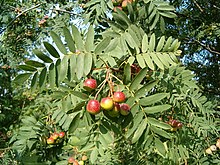Sorbus domestica
| Sorbus domestica | |
|---|---|
 |
|
| Scientific classification | |
| Kingdom: | Plantae |
| (unranked): | Angiosperms |
| (unranked): | Eudicots |
| (unranked): | Rosids |
| Order: | Rosales |
| Family: | Rosaceae |
| Genus: | Sorbus |
| Subgenus: | Cormus |
| Species: | S. domestica |
| Binomial name | |
|
Sorbus domestica L. |
|
 |
|
| Distribution map | |
| Synonyms | |
|
|
Sorbus domestica, with the common name service tree, is a species of Sorbus native to western, central and southern Europe, northwest Africa (Atlas Mountains), and southwest Asia (east to the Caucasus).
It is a deciduous tree growing to 15–20 m (rarely to 30 m) tall with a trunk up to 1 m diameter, though can also be a shrub 2–3 m tall on exposed sites. The bark is brown, smooth on young trees, becoming fissured and flaky on old trees. The winter buds are green, with a sticky resinous coating. The leaves are 15–25 cm long, pinnate with 13-21 leaflets 3–6 cm long and 1 cm broad, with a bluntly acute apex, and a serrated margin on the outer half or two thirds of the leaflet. The flowers are 13–18 mm diameter, with five white petals and 20 creamy-white stamens; they are produced in corymbs 10–14 cm diameter in late spring, and are hermaphrodite and insect pollinated. The fruit is a pome 2–3 cm long, greenish-brown, often tinged red on the side exposed to sunlight; it can be either apple-shaped (f. pomifera (Hayne) Rehder) or pear-shaped (f. pyrifera (Hayne) Rehder).
It is generally rare, listed as an endangered species in Switzerland and Austria, and uncommon in Spain. In the UK, one very old tree that existed in the Wyre Forest before being destroyed in 1862 used to be considered native, but it is now generally considered to be more likely of cultivated origin, probably from a mediaeval monastery orchard planting. More recently, a small population of genuinely wild specimens was found growing as stunted shrubs on cliffs in south Wales (Glamorgan) and nearby southwest England (Gloucestershire). It is a very rare species in Britain, occurring at only a handful of sites. Its largest English population is within the Horseshoe Bend Site of Special Scientific Interest at Shirehampton, near Bristol.
...
Wikipedia
